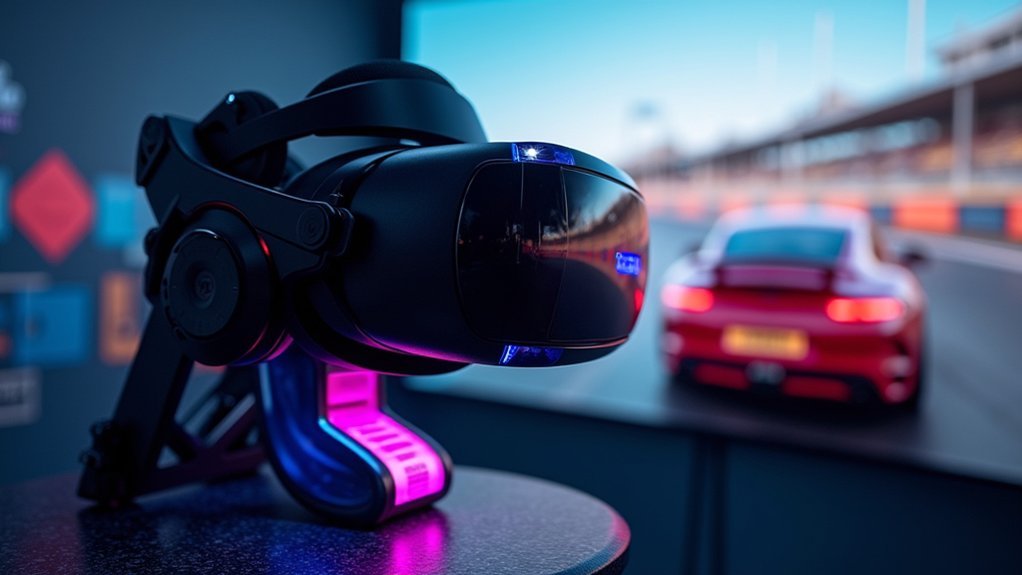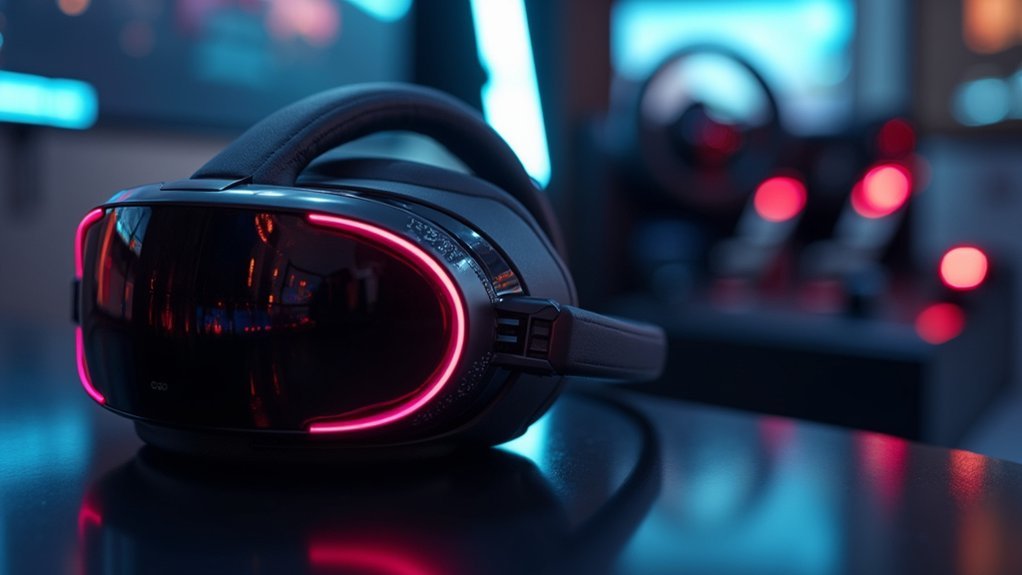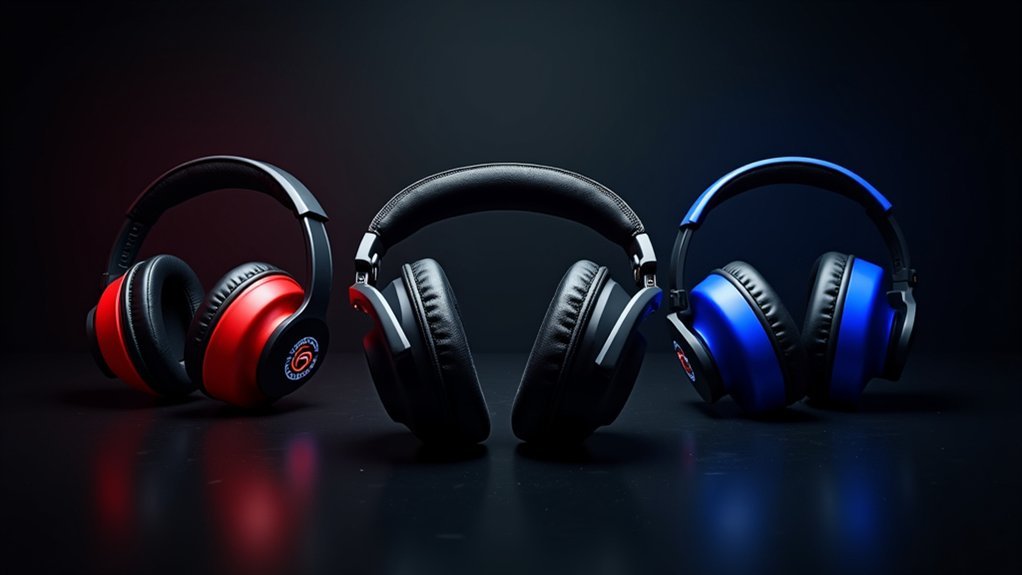For sim racing, you’ll find three excellent VR headset options across different budgets. The Oculus Rift S offers great value at around $300 with its 115° field of view and simple setup. The Meta Quest 3 delivers premium wireless performance in the mid-range category. For the ultimate experience, the HP Reverb G2 provides stunning 2160×2160 resolution per eye that transforms your racing immersion. Let’s explore how each option enhances your virtual track performance.
Top Budget-Friendly VR Headsets for Sim Racing

While high-end VR headsets can break the bank, several budget-friendly options offer impressive performance for sim racing enthusiasts.
The Oculus Rift S stands out at around $300, featuring a 115° field of view and integrated sensors that eliminate the need for external hardware.
The Rift S delivers wide-angle immersion with hassle-free setup—perfect for racers seeking value without sacrificing performance.
If you’re seeking superior visual quality, consider the HP Reverb G2. At roughly $200 used, it delivers exceptional 2160 x 2160 resolution per eye. These budget options still provide immersive racing experience despite their lower price points.
For extreme budget constraints, the second-hand Oculus Rift CV1 remains viable at half the Rift S’s price.
The Lenovo Explorer competes well with pricier models, while the Meta Quest 2 offers standalone functionality.
When choosing, consider compatibility with your PC, comfort for extended sessions, and whether you’re prone to motion sickness.
Mid-Range VR Options With Premium Performance
For sim racing enthusiasts seeking a sweet spot between affordability and high-end performance, mid-range VR headsets deliver exceptional value. Priced between $600-$1,200, these headsets offer resolutions from 1440×1660 to 2064×2208 per eye, providing immersive racing experiences with near 360° track views.
- Meta Quest 3 offers well-rounded performance with wireless capabilities, though you’ll likely want external headphones for ideal 3D audio.
- Valve Index delivers excellent visuals with its 1440×1660 resolution and comfortable design for extended racing sessions.
- HTC Vive Cosmos features advanced tracking technology that enhances your driving precision.
- Pico Neo 3 Link provides more responsive performance through its DisplayPort connection, reducing latency during critical racing moments.
These options include IPD adjustment features to customize your visual experience and guarantee clarity during intense races. Most users report that VR headsets significantly enhance sense of speed when compared to traditional monitor setups.
High-End VR Headsets for the Ultimate Racing Experience

Serious sim racing enthusiasts seeking unmatched immersion should consider high-end VR headsets, which represent the pinnacle of virtual racing technology.
Models like the Pimax Crystal and Pimax 8KX deliver exceptional visual clarity with resolutions exceeding 1832 x 1920 per eye and FOVs approaching 200°.
The HP Reverb G2 offers impressive 2160 x 2160 resolution per eye, while the HTC Vive Pro 2 provides premium features at a higher price point.
Samsung Odyssey balances performance with value.
These premium headsets enhance depth perception, track awareness, and overall realism with their advanced tracking systems and 3D audio capabilities.
Though typically costing over £500, they provide long-term value through superior comfort during extended sessions and compatibility with future racing titles. The Pimax Crystal stands out particularly for simulation games, offering excellent visual fidelity but requiring a powerful PC and being somewhat bulky for mobile gaming.
Frequently Asked Questions
How Long Do VR Headset Batteries Typically Last During Racing Sessions?
Your VR headset will typically last 1-2.5 hours during racing sessions. You’ll get about 1.5 hours wirelessly, but graphically intensive racing games will drain the battery faster. Consider battery extenders for longer sessions.
Can VR Headsets Be Used With Prescription Glasses?
Yes, you can use VR headsets with prescription glasses, though fit varies by model. For better comfort, you’ll find prescription lens inserts available from companies like VR Optician that eliminate the need for glasses entirely.
What Wireless Solutions Exist for VR Sim Racing Setups?
For wireless VR sim racing, you’ll find the Meta Quest 3 offers a completely cable-free experience. You can also use HTC Vive Pro 2 wirelessly with additional base stations, though it’s less common.
How Can I Reduce Motion Sickness While Racing in VR?
You can reduce VR racing motion sickness by starting with short sessions, ensuring proper headset fit, staying hydrated, taking regular breaks, and focusing on fixed points. Consider anti-sickness bands or ginger supplements if needed.
Are VR Headsets Backward Compatible With Older Racing Simulators?
Backward compatibility varies. Newer VR headsets often work with older simulators if they’ve been updated for VR support, but many legacy titles lack VR integration entirely. You’ll need to check each simulator’s compatibility specifically.
In Summary
You’ve now explored the best VR headsets across every price point for your racing simulator setup. Whether you’re just starting out with an entry-level option or you’re ready to invest in premium performance, there’s a perfect match for your needs. Remember to take into account your PC specs, comfort preferences, and budget before making your choice. Your perfect virtual racing experience awaits—it’s time to grab the wheel!





Leave a Reply